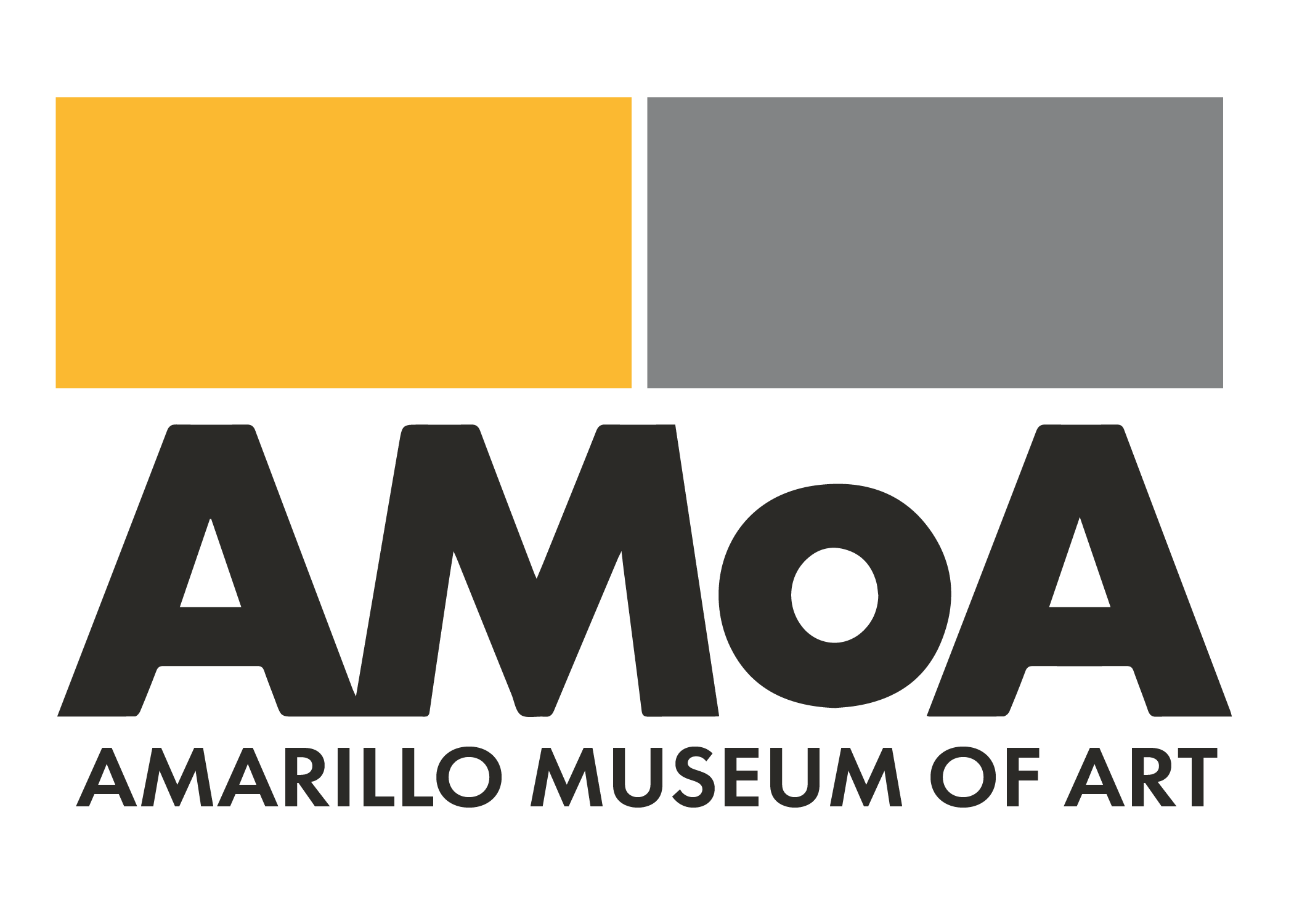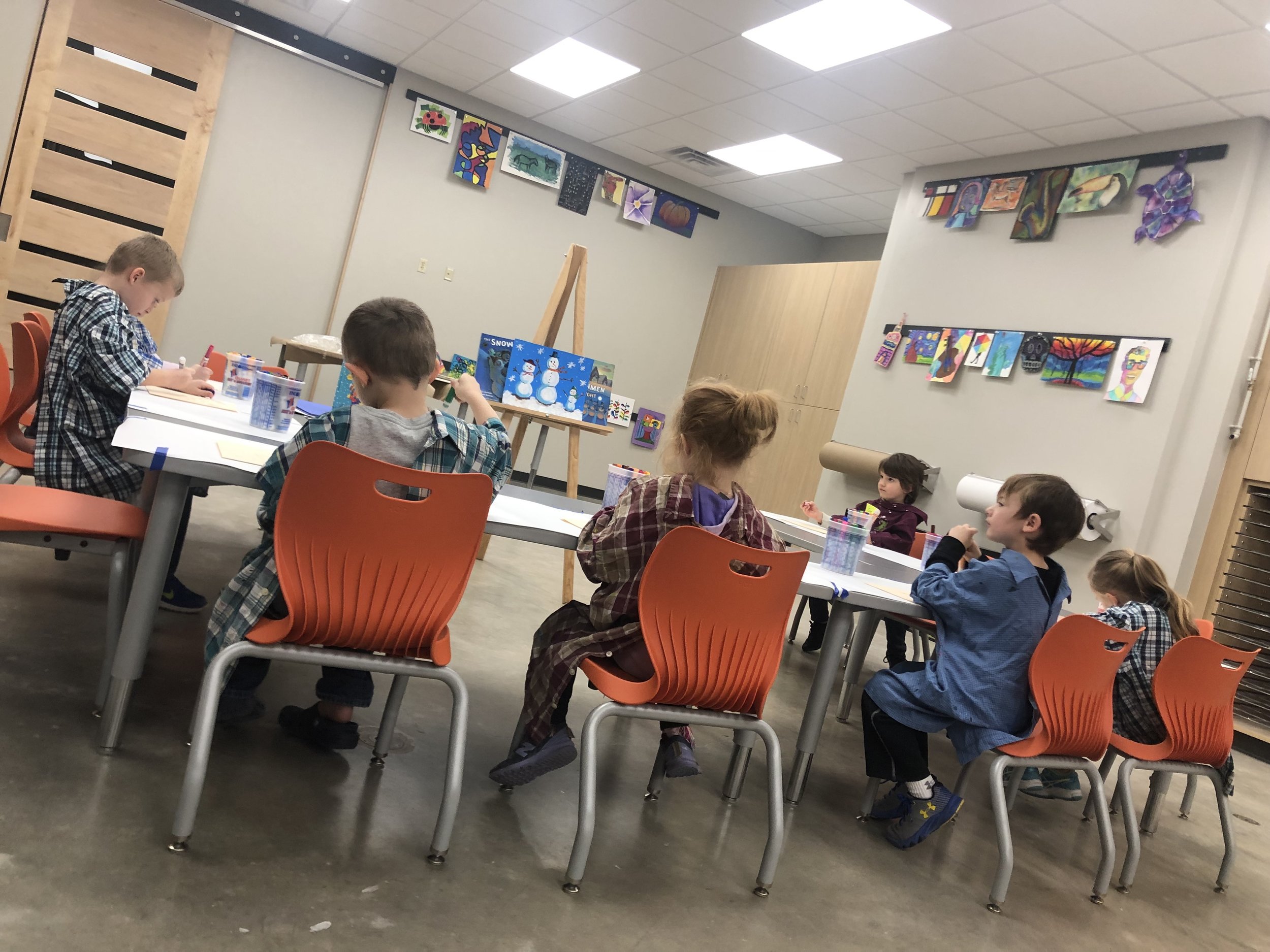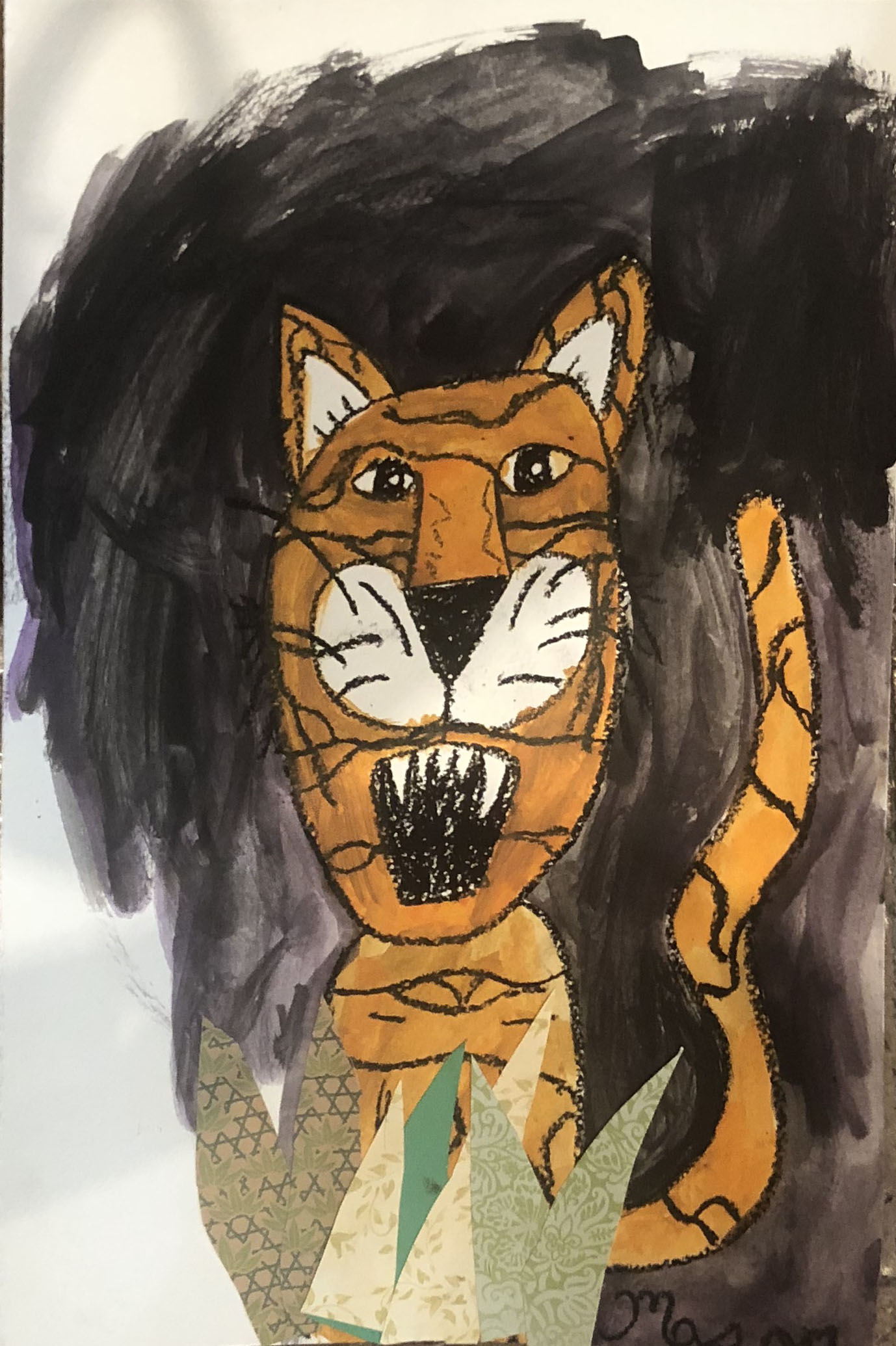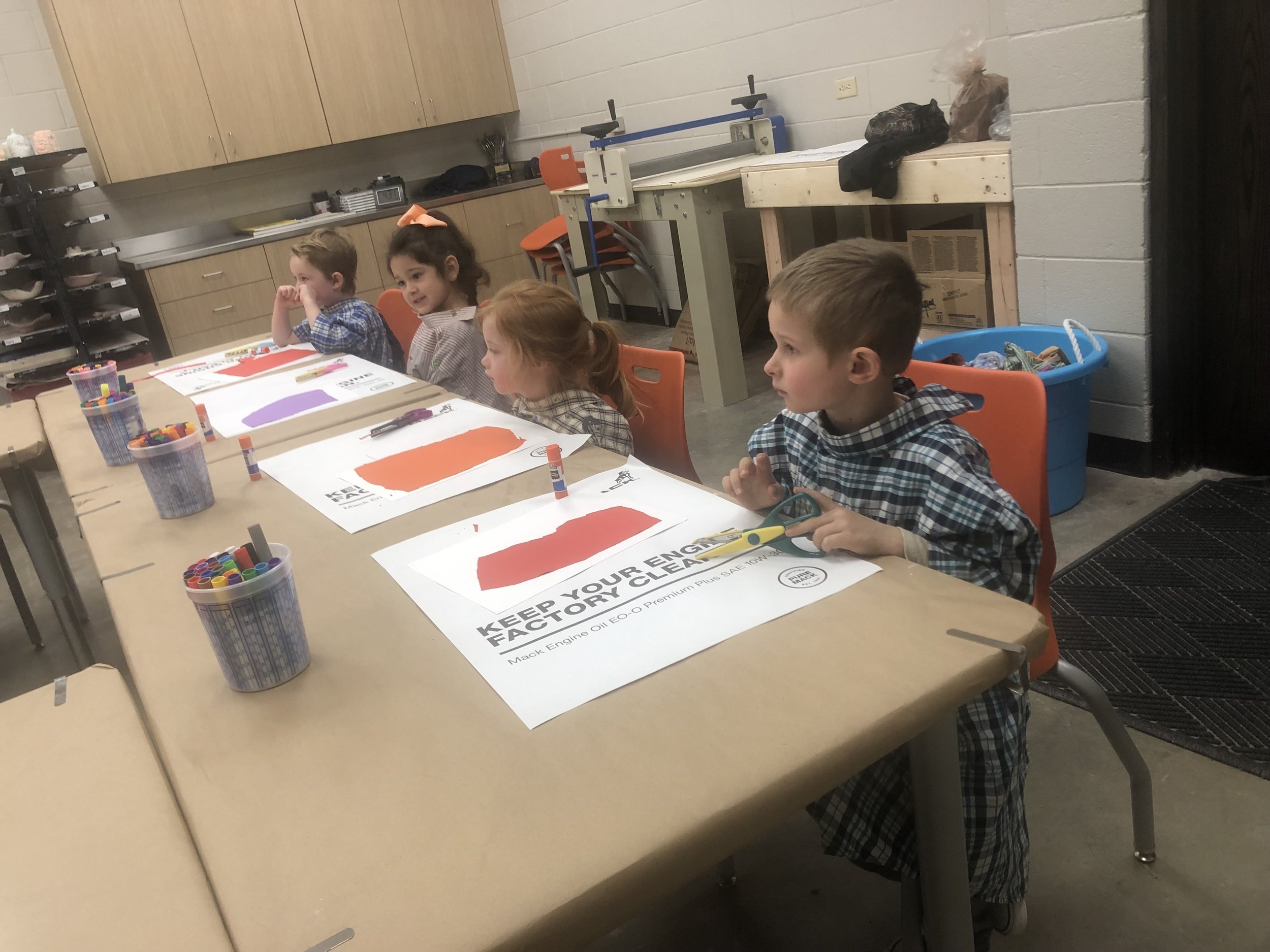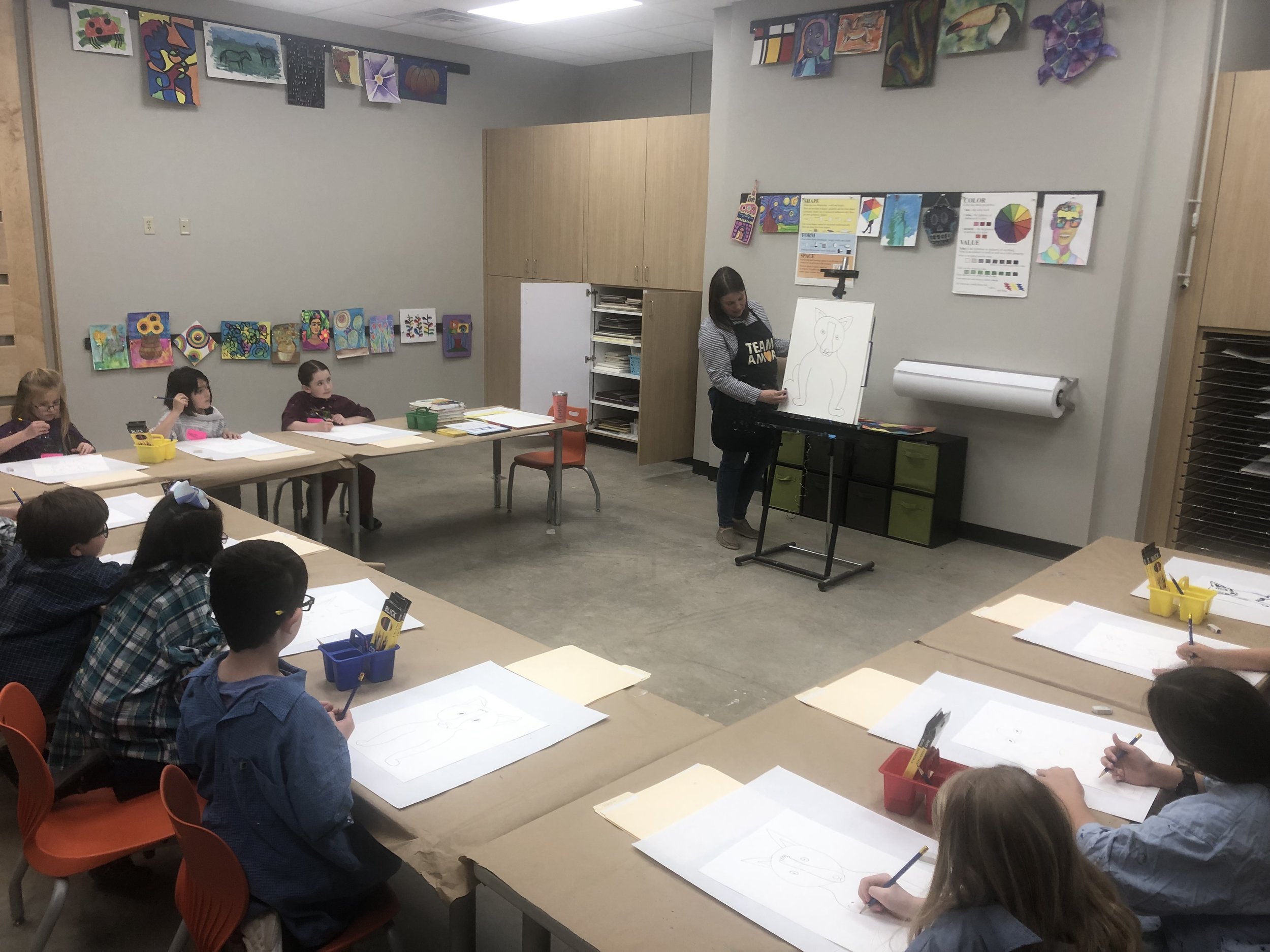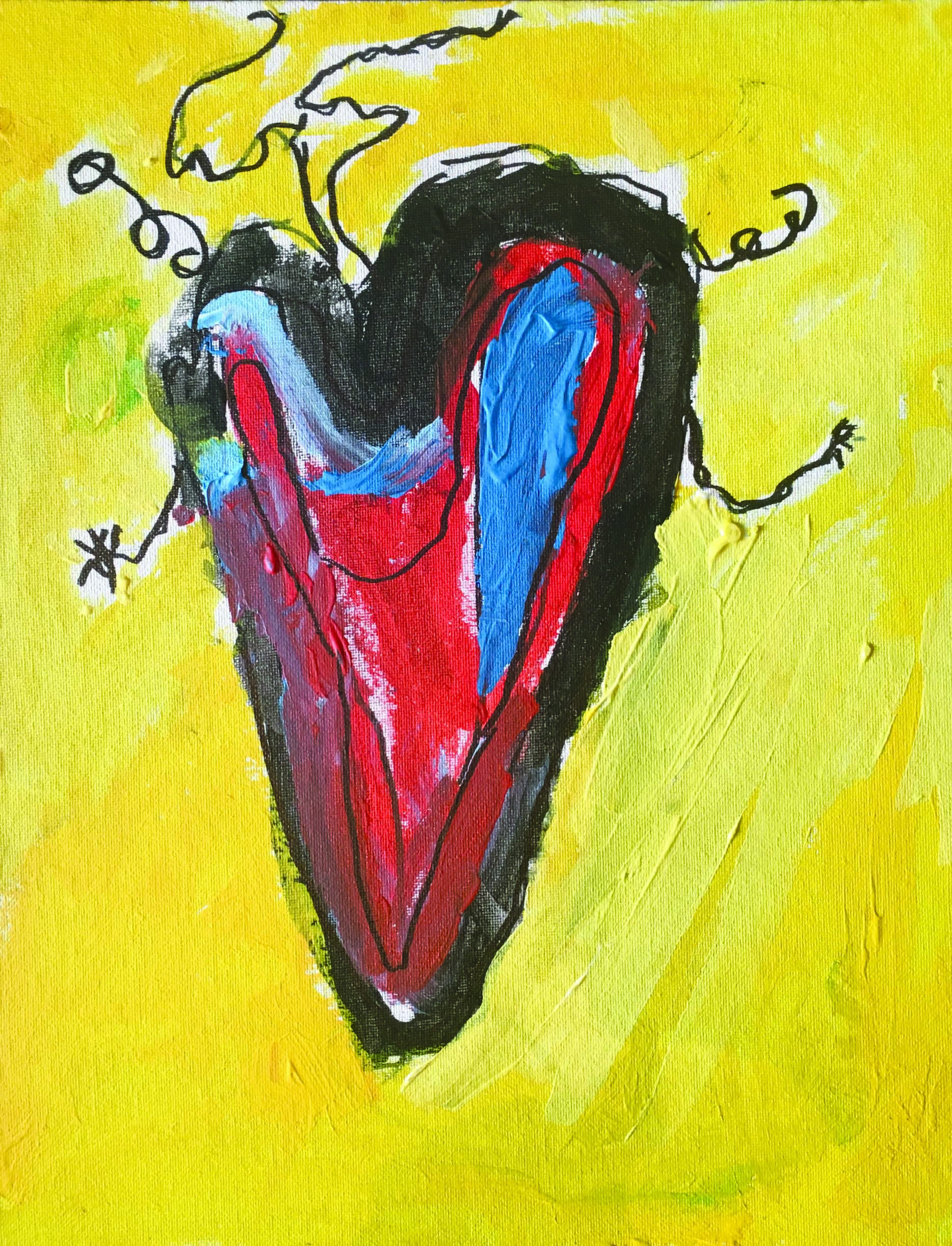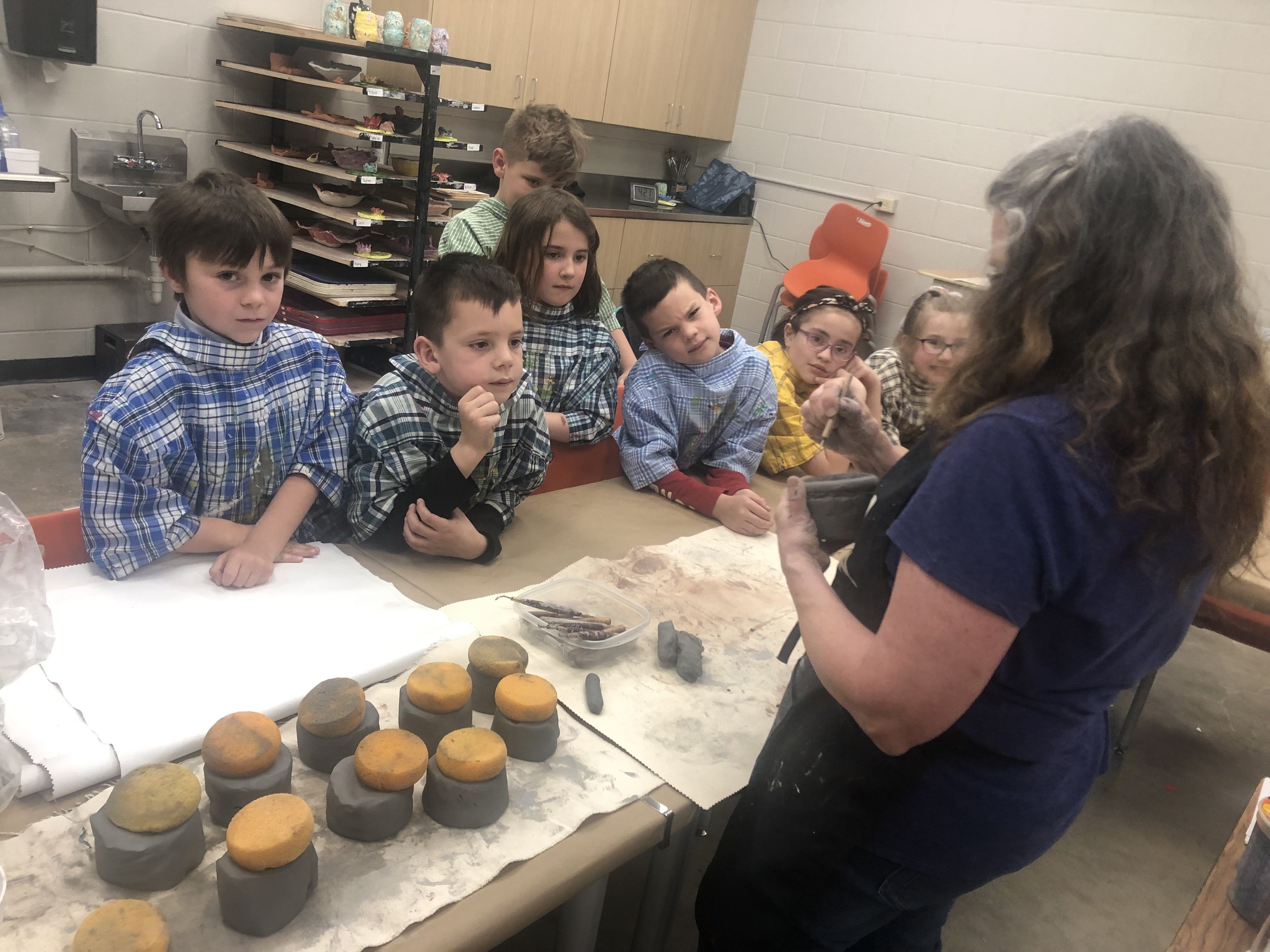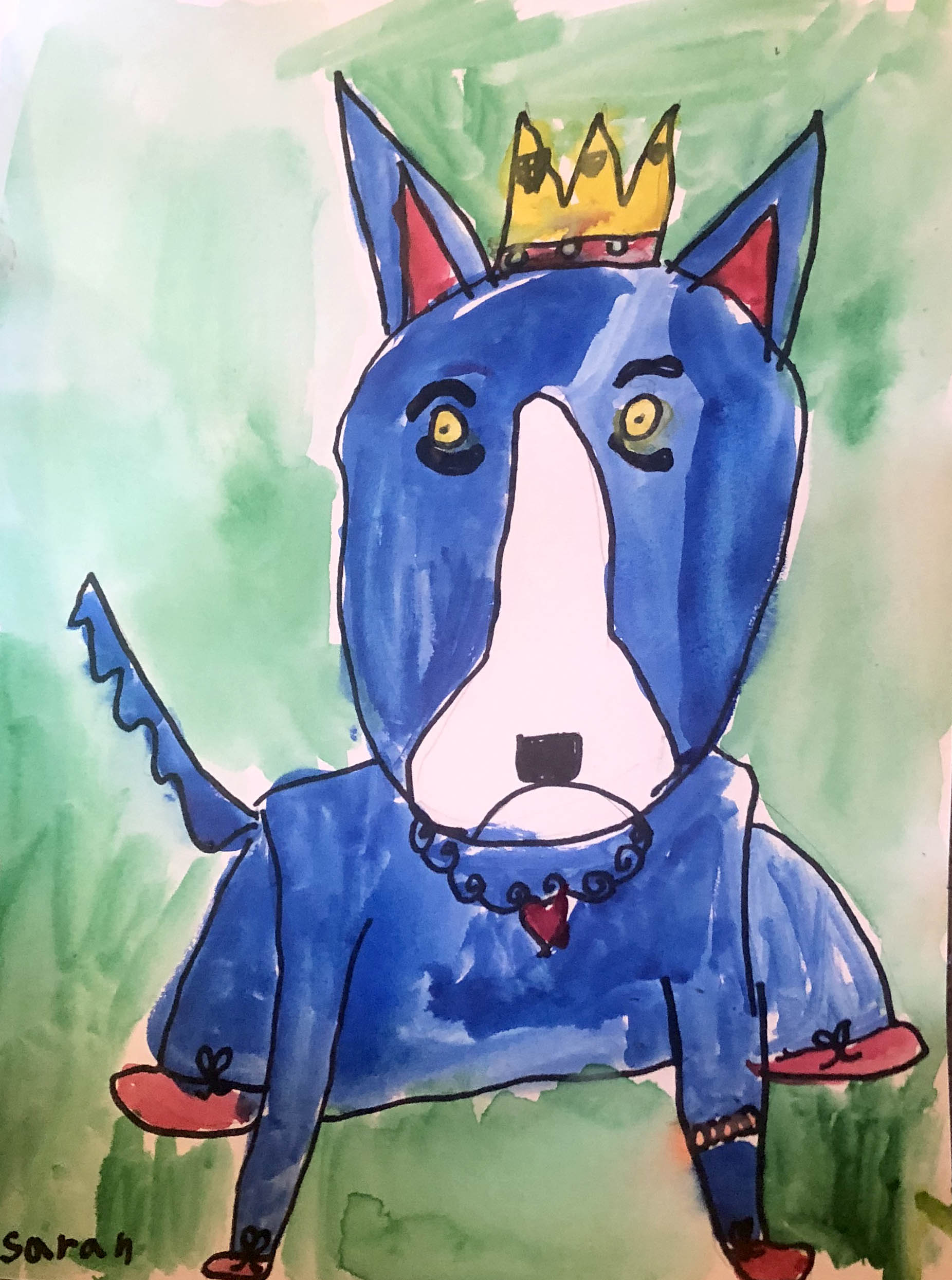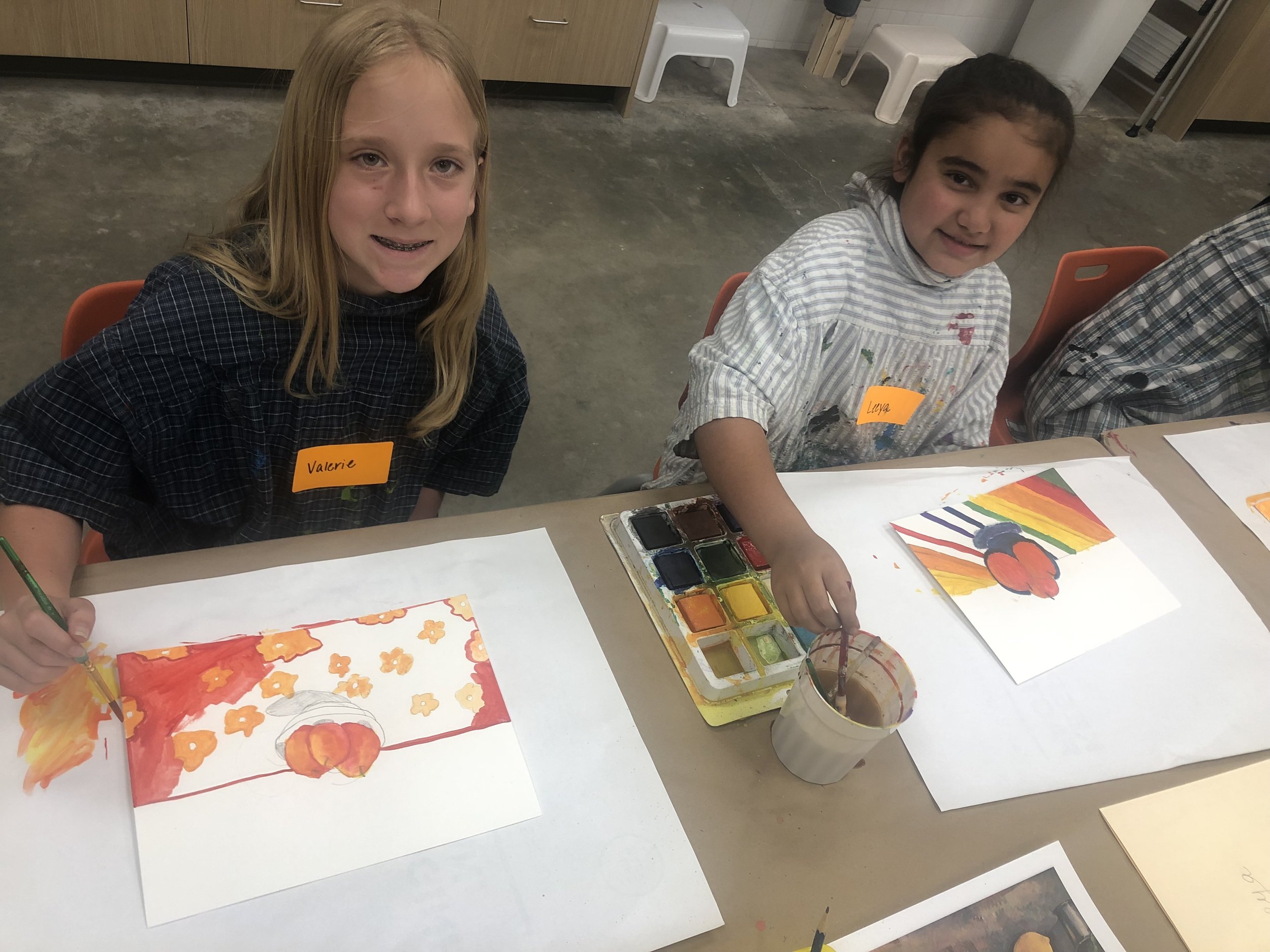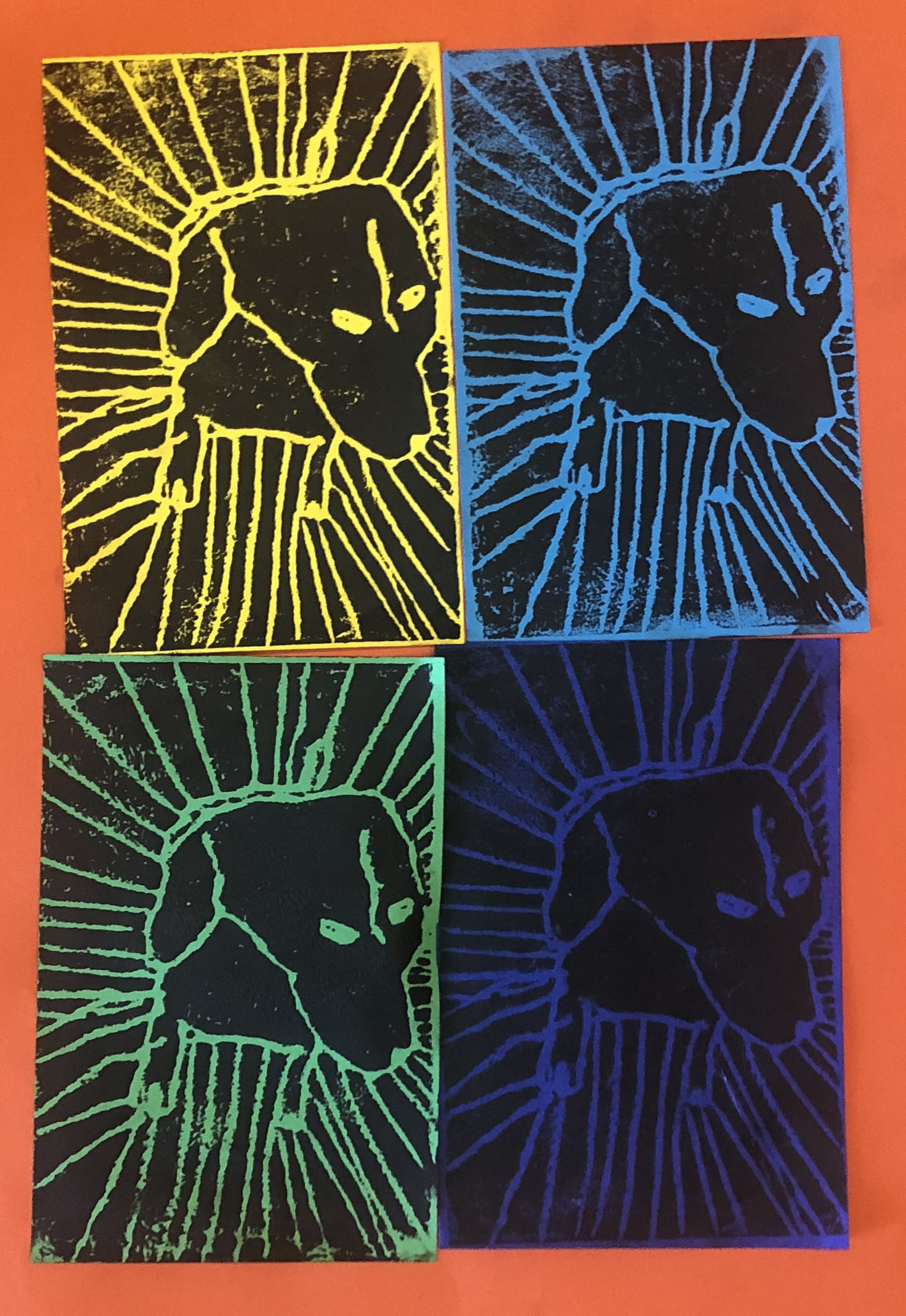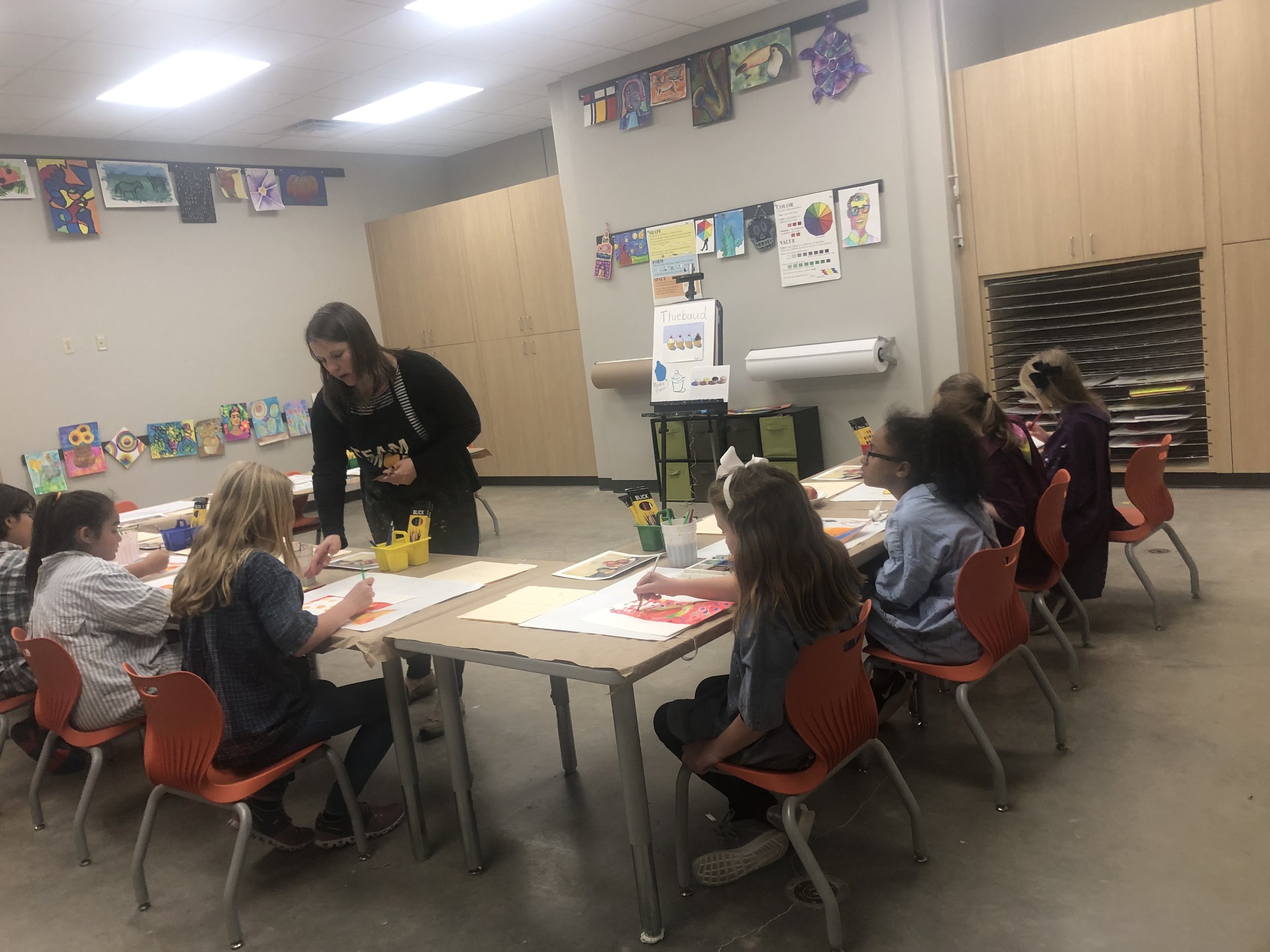Create artworks with AMoA from home! Young artists can explore drawing, painting, mixed media, sculpture and design through a series of weekly online art lessons. Project themes and materials lists will be posted each Monday, followed on Wednesday by a step-by-step video tutorial with one of AMoA’s Museum School Teachers.
GENEROUS SUPPORT FOR THIS PROJECT PROVIDED BY ART BRIDGES
DALI-INSPIRED CLAY ART
“…People love mystery, and that is why they love my paintings.”
- Salvador Dali
Dali-Inspired Clay Art Activity
Join Cecilia Rios, AMoA Museum School Teacher, to create clay art in the style of Salvador Dali. You will need the following materials:
• Clay (Cecilia is using terra cotta, but you can substitute air dry clay or salt dough)
• Rolling pin
• Objects to use as templates/forms (such as a plate, bowl, or box)
• Various sculpting tools (if you do not have formal sculpting tools, substitute household objects such as
pen, skewer, fork, popsicle stick, etc.)
• Squirt bottle filled with water
• Sponge
• Small container and water to create slip
• Various colors of paint
• Paint brushes in various sizes
EXPLORE SALVADOR DALI AND CLAY ART
Salvador Dali Museum
This surreal museum in St. Petersburg, Florida is home to an unparalleled collection of Salvador Dali artwork.
Salvador Dali Museum
Salvador Dali
MoMA
Let the Modern Museum of Art show you more about this week’s featured artist.
MoMA – Salvador Dali
Who is Salvador Dali?
Tate Kids
Welcome to the weird and wonderful world of Salvador Dali, specifically for children.
Tate.org – Salvador Dali
Surrealism
Heilbrunn Timeline of Art History
The Metropolitan Museum of Art
With origins in literature and the work of poet and critic Andre Breton, Surrealism experiments with the release of the imagination.
The Metropolitan Museum of Art – Surrealism
11 Innovative Ceramic Artists Breathing New Life into an Age-Old Art
Kelly Richman-Abdou
My Modern Met, May 29, 2017
The contemporary artists are reinventing traditional ceramic art in ways that span the difference between thought-provoking and playful.
My Modern Met – Innovative Ceramic Artists
RELATED ACTIVITY LESSONS
Stained glass and mosaic art are time honored traditions that have been in use for over 1,000 years. Continue your exploration through the humanities with the following resources:
Exquisite Corpse Game
Created by a group of surrealist artists, this drawing technique is a fun activity for a group. Based on a parlor game called Consequences, Exquisite Corpse is much like a drawn version of Mad Libs. Using just paper and drawing tools, each participant adds to the drawing without seeing what has already been added, then passes it on to create a collaborative artwork.
Click on the link below to learn more about Exquisite Corpse:
Artsy.net – Exquisite Corpse
Create a Surrealism Poem
The surrealists were always looking for new ways to explore their creativity. Follow the instructions below to change the order of an existing passage and create something entirely new!
1. Find a paragraph of text in a newspaper paper or magazine.
2. Cut out each word individually and place in a container.
3. Shake the container, removing each word one at a time.
4. Glue the words to a piece of paper in the order in which you remove them from the container to create an entirely
new surrealist poem.
SUGGESTED READING LIST
The Secret Life of Salvador Dali, by Salvador Dali, Haakon Chevalier (Translator)
Salvador Dali: 1904 - 1989, by Gilles Neret, Catherine Plant (Translator)
The Absence of Myth: Writings on Surrealism, by Georges Bataille, Michael Richardson (Editor)
Dali and the Path of Dreams, by Anna Obiols and Joan ‘Subi’ Subirana
Salvador Dali (Getting to Know the World’s Greatest Artists), by Mike Venezia
“STAINED GLASS” PAPER MOSAIC
“…People are like stained glass windows. They sparkle and shine when the sun it out, but when the darkness sets in, their true beauty is revealed only if there is a light from within.”
- Elisabeth Kubler-Ross
“Stained Glass” Paper Mosaic Art Activity
Join Cecilia Rios, AMoA Museum School Teacher, to create either an abstraction or nature inspired scene with cut paper. You will need the following materials:
• Large piece of black construction paper or cardstock
• Various colors of construction paper or cardstock
• Pencil
• Scissors
• Glue stick
Materials for alternative version on canvas: canvas, black paint, paint brush, pencil, various colors of construction paper, scissors, liquid glue
EXPLORE STAINED GLASS AND MOSAIC
Stained Glass
Robert Sowers, stained glass artist and author
Britannica
The author of The Language of Stained Glassand other books on the subject, Sowers is an expert in the medium.
Britannica - Stained Glass
History of Stained Glass
The Stained Glass Association of America
The Stained Glass Association of America is the professional trade association for Architectural Art Glass and has been a community of glass professionals and aficionados for over 100 years.
The Stained Glass Association – History of Stained Glass
Louis Comfort Tiffany (1848 – 1933)
Heilbrunn Timeline of Art History, The Metropolitan Museum of Art
Tiffany is one of America’s most acclaimed artists, whose career creating stained glass, lamps, and jewelry spanned over 50 years.
Tiffany – A Timeline
From Henri Matisse to Judy Chicago, 9 Artists Who Designed Dazzling Stained Glass Windows
Charlotte Hecht
Artsy, November 7, 2017
If the idea of stained glass brings to mind dark churches and religious imagery, consider how these 9 artists re-imagined the medium.
Artsy – Stained Glass, Re-imagined
8 Contemporary Stained Glass Artists Who Are Redefining the Ancient Craft
Emma Taggart
My Modern Met, April 19, 2018
Contemporary artists are embracing the craft of stained glass in ways that are fresh, new and anything but outdated.
My Modern Met – Contemporary Stained Glass Artists
A History of Mosaics: The Art of Puzzles
Google Arts & Culture
Mosiac and stained glass are created when smaller objects come together to create a larger image. Explore this ancient history of mosaic, piece by piece, like a puzzle.
Google Arts and Culture – A History of Mosaics
RELATED ACTIVITY LESSONS
Stained glass and mosaic art are time honored traditions that have been in use for over 1,000 years. Continue your exploration through the humanities with the following resources:
Create a Lego Mosaic using the Grid Method
Mosaics are created by assembling small pieces of material such as tile, glass or stone in a pattern to create a larger image. This lesson will use math and the grid method to transfer an image to a Lego baseplate for a finished mosaic.
Click here for more information on the grid method and instructions to create your own Lego Mosaic.
Rose Windows: Definition, Design & Symbolism
Rose windows are dramatic circular stained glass windows and are an important part of Gothic architecture. This lesson from Study.com explores the history and meanings behind them.
SUGGESTED READING LIST
The Language of Stained Glass, by Robert Sowers
Stained Glass: From its Origins to the Present, by Virginia Chieffo Raguin
The Art Glass of Louis Comfort Tiffany, by Paul E. Doros
The Ghost from the Stained Glass Window, by Karen Leiby Belli (author) and Anneliese Van Dommelen (illustrator)
WARHOL ONOMATOPOEIA POP ART
“…art is what you can get away with.” – Andy Warhol
Warhol Onomatopoeia Pop Art Activity
Join Cecilia Rios, AMoA Museum School Teacher, to create an artwork inspired by Andy Warhol and the Pop Art Movement. You will need the following materials:
• Various colors of construction paper
• White computer paper
• Newspaper
• Pencil
• Sharpie (or other black marker)
• Scissors
• Xcto knife/craft or utility knife and cutting mat (optional, use only with adult supervision)
• Glue stick
EXPLORE ANDY WARHOL AND POP ART
The Andy Warhol Museum
Located in Pittsburgh, Pennsylvania, the place of Andy Warhol’s birth, this museum holds the largest collection of Warhol’s artworks and archival materials and is one of the most comprehensive single-artist museums in the world.
The Andy Warhol Museum
Who Is Andy Warhol?
Tate Kids
Andy Warhol is one of the most famous artists, ever. From his soup to his hair, he is an art legend.
Tate Kids – Andy Warhol
Andy Warhol (American, 1928 – 1987)
ArtNet
Learn more about the prolific artist and his contemporaries, like Roy Lichtenstein, through a brief biography and works currently for sale on the open market.
ArtNet – Andy Warhol
Roy Lichtenstein
The Broad
A pioneer of the Pop Art movement, Lichtenstein’s use of text, heavy black outlines, and benday dots mimic the look of traditional comic books.
The Broad – Roy Lichtenstein
Pop Art
MoMA Learning
Explore how Pop artists, including Andy Warhol, were inspired by – and made art directly from – consumer goods, mass media, and popular culture.
RELATED ACTIVITY LESSONS
Pop art is inspired by, and made from, everyday objects. Continue your exploration through the humanities of this famous art style with the following resources:
Create Your Own Comic Strip
Who doesn’t love a good comic? This activity uses 3x3 inch sticky notes to create a multi-panel story in the style of traditional comic strips.
Click here for instructions to create your own comic strip and printable template.
Onomatopoeia Sketch Challenge
Play a version of the classic sketching game Pictionaryusing onomatopoeia words.
Click here for instructions and game pieces for the Onomatopoeia Sketch Challenge
SUGGESTED READING LIST
The Philosophy of Andy Warhol (From A to B and Back Again), by Andy Warhol
Where’s Warhol?: Take a journey through art history with Andy Warhol!, by Catherine Ingram
Andy Warhol So Many Stars, by Mudpuppy and Andy Warhol
Pop Art, by Lucy R. Lippard
Tate Movements in Modern Art: Pop Art, by David McCarthy
THIEBAUD-INSPIRED ICE CREAM PAINTING
“…it is a realization that [painting] is a craft as well as an activity that you pursue like a scientist…find something as fresh, or new, or different as you can.”
- Wayne Thiebaud
Thiebaud-Inspired Ice Cream Painting Activity
Join Cecilia Rios, AMoA Museum School Teacher, to create an artwork inspired by the ice cream paintings of Wayne Thiebaud. You will need the following materials:
• Canvas or canvas panel (Cecilia is using 11x14)
• Tempera or acrylic paint in various colors
• Paintbrushes in various sizes
• Palette or small containers for paint
• Ruler
• Pencil
• Scratch paper
• Tape (optional)
EXPLORE WAYNE THIEBAUD
Wayne Thiebaud Whitney Museum of American Art
Wayne Thiebaud ArtNet
An Interview with Wayne Thiebaud
In conversation with KQED’s Michael Krasny
In 2019, KQED Forum host Michael Krasny interviewed Wayne Thiebaud for California College of the Arts in celebration of Thiebaud’s prolific art career and decades of service as an art educator.
California College of the Arts – Wayne Thiebaud
Collecting Guide: Wayne Thiebaud Christie’s
This article by Christie’s, the famous auction house, explores Theibaud’s work beyond his quintessential paintings of cakes and other sweets. Subjects such a portraits and landscapes reverberate with color as the artist gets his just desserts in the art world as he approaches 100.
Christie's – Wayne Thiebaud
Wayne Thiebaud is Not a Pop Artist
Cathleen McGuigan, Smithsonian Magazine
This interview looks at Thiebaud’s place in contemporary art in preparation for a retrospective exhibition at the Crocker Art Museum in Sacramento in 2011.
Smithsonian Magazine – Wayne Thiebaud
RELATED ACTIVITY LESSONS
Wayne Theibaud’s colorful paintings of cakes, pies and other desserts can inspire all sorts of fun summer-time activities. Continue your exploration through the humanities with the following resources:
Coffee Can Ice Cream Activity
Is it really summer if you haven’t rolled a can down the sidewalk to create home-made ice cream? Take your dessert outside (and work off some of that youthful energy!) with this sweet activity.
Click here for Coffee Can Ice Cream recipe and instructions.
Wayne Thiebaud: Cakes! Math and Visual Arts Integration Lesson
This lesson from the Institute for Arts Integration and STEAM uses cake paintings by Wayne Thiebaud to explore basic geometry, 3-D design and perspective.
Institute for Arts Integration and STEM – Wayne Thiebaud
SUGGESTED READING LIST
Wayne Thiebaud: A Paintings Retrospective, by Steven A. Nash and Adam Gopnik
Delicious: The Life & Art of Wayne Thiebaud, by Susan Goldman Rubin
California Landscapes: Richard Diebenkorn/Wayne Thiebaud, by John Yau, Philippe de Montebello (contributor), Wayne Thiebaud (contributor)
Counting with Wayne Thiebaud, by Susan Goldman Rubin and Wayne Thiebaud
SONIA DELAUNAY GEOMETRIC ART
“Colour is the skin of the world. Colour was the hue of number. One who knows how to appreciate colour relationships, the influence of one colour on another, their contrasts and dissonances, is promised an infinitely diverse imagery.” – Sonia Delaunay
Sonia Delaunay Geometric Art Activity
Join Cecilia Rios, AMoA Museum School Teacher, to create a colorful pastel inspired by the geometric artworks of Sonia Delaunay. You will need the following materials:
• Pastel pencils (colored pencils or paint will also work)
• Pencil
• Paper or cardstock
• Sharpie or other black marker
• Compass
• Various sizes of cups
• Ruler
• Blending stumps or cotton swabs
EXPLORE SONIA DELAUNAY AND GEOMETRIC ART
Who is Sonia Delaunay?
In addition to abstract and geometric art, Delaunay was also interested in interior design and fashion.
Tate Museum
Sonia Delaunay: the avant-garde queen of loud, wearable art
Kathleen Jamie, The Guardian, March 27, 2015
This article takes a deeper look at the 2015 Delaunay exhibition at the Tate and the artist’s work in fashion.
The Guardian
Sonia Delaunay by David Seidner
INTERVIEWER’S NOTE: This interview took place in Paris in the Spring of 1978. From what I understand, it was the last ever done with Sonia Delaunay as she lost her voice shortly thereafter, and died in the winter of the following year.
BOMB Magazine
Frank Stella
Guggenheim
Museum of Modern Art
Josef Albers
Josef & Annie Albers Foundation
Smithsonian American Art Museum
RELATED ACTIVITY LESSONS
Continue your exploration of Sonia Delaunay and geometric art through the humanities with the following resources:
Math + Arts, Geometric Quilts
Be inspired by Sonia Delaunay’s love of textiles to create a quilt using geometry.
PBS Learning Media
Rhythmic Geometric Abstraction Lesson
This lesson from Albright-Knox pairs Sonia Delaunay’s painting Colored Rhythmwith music to introduce students the Orphism movement through emphasis on color, shape, pattern, and rhythm.
Albright-Knox
SUGGESTED READING LIST
Sonia Delaunay, by Anne Montfort (editor)
Madame Sonia Delaunay: A Pop-Up Book, by Gérard Lo Monaco
Sonia Delaunay: A Life of Color, by Cara Manes and Fatinha Ramos
Frank Stella,by William Rubin
Josef Albers in Mexico, by Lauren Hinkson and Joaquin Barríendos
NEVELSON FOUND OBJECT ASSEMBLAGE
Who Was Louise Nevelson
Born in the Russian Empire (present-day Ukraine), Louise Nevelson emigrated to the United States as a child. Experimenting with early conceptual art, Nevelson dedicated her career to sculpture. Often made of wood and painted in monochromatic black or white, Nevelson is best known for her puzzle-like assemblage works. Assemblage refers to the act of assembling various objects, often everyday items scavenged by the artist. Nevelson is an internationally known artist and her work is found in major collections around the world, including the AMoA permanent collection.
EXPLORE LOUISE NEVELSON FURTHER
Louise Nevelson, 1899-1988
The Tate Museum
Louise Nevelson, 1899-1988
National Museum of Women in the Arts
Sky Cathedral, Louise Nevelson
MoMA Learning
Sculptor Louise Nevelson
CBS Sunday Morning - YouTube Video
Louise Nevelson
Britannica Kids
RELATED ACTIVITY LESSON
Use Louise Nevelson’s ideas about assemblage and apply them to a different medium. Instead of wood, follow the steps in this unique lesson to create an assemblage collage out of textiles, like bits of yarn, fabric and other woven materials.
Fabric Assemblage
SUGGESTED READING LIST
The Sculpture of Louise Nevelson, by Brooke Kamin Rapaport, Arthur C. Danto, et al.
Louise Nevelson: Light and Shadow, by Laurie Wilson
Women in Art: 50 Fearless Creatives Who Inspired the World, written and illustrated by Rachel Ignotofsky
O’KEEFE-INSPIRED FLORAL COLLAGE
“Nobody sees a flower - really - it is so small it takes time - we haven’t time - and to see takes time, like to have a friend takes time.”
– Georgia O’Keefe
O’Keeffe-Inspired Floral Collage Art Activity
Join Cecilia Rios, AMoA Museum School Teacher, to create a collage inspired by the floral compositions of Georgia O’Keeffe.
You will need the following materials:
• pencil
• paintbrush
• watercolor paper or cardstock
• multicolored tissue paper
• school glue
EXPLORE GEORGIA O’KEEFFE
Georgia O’Keeffe Museum
Located in Santa Fe, New Mexico, the museum is dedicated to the life and work of Georgia O’Keeffe.
okeeffemuseum.org
Who Is Georgia O’Keeffe?
Take the time to look at the world with Georgia O’Keeffe through the eyes of Tate Kids, an art website for kids created by the Tate.
tate.org
Georgia O’Keeffe (1887-1986)
The Heilbrunn Timeline of Art History, The Metropolitan Museum of Art
This essay summarizes O’Keeffe’s impact on American Art and includes links to related topics.
metmuseum.org
RELATED ACTIVITY LESSONS
Georgia O’Keeffe was not the first, or only, person to be inspired by flowers. Continue your exploration of flowers through the humanities with the following resources:
Flower Scavenger Hunt
Explore your neighborhood with this flower-based scavenger hunt.
Flowers from Emily Activity
If we love Flowers, are we not ‘born again’ every Day?
- Emily Dickinson, Letter 1037
This lesson from the National Endowment for the Humanities explores the influence of gardening and flowers on the life and poetry of Emily Dickinson.
edsitement.neh.gov
SUGGESTED READING LIST
Georgia O’Keeffe: Watercolors, by Amy Von Lintel
Portrait of an Artist: A Biography of Georgia O’Keeffe, by Laurie Lisle
Georgia O’Keeffe: Catalogue Raisonne, by Barbara Buhler Lynes
My Name is Georgia: A Portrait, by Jeanette Winter
Through Georgia’s Eyes, by Rachel Victoria Rodriguez and Julie Paschkis
STACKED SALT DOUGH SCULPTURES
“My curiosity was aroused by the idea of giving structural form to the images in my drawings. These forms come from observing plants, the spiral shell of a snail, seeing light through insect wings, watching spiders repair their webs in the early morning, and seeing the sun through the droplets of water suspended from the tips of pine needles while watering my garden.”
– Ruth Asawa
This week’s stacked sculpture activity is inspired by the organic forms of modern sculpture artists such as Ruth Asawa, Barbara Hepworth, Jean Arp and Constantin Brancusi. Their rounded shapes, pierced forms were inspired by the natural world and reinterpreted sculpture as an art form.
This project is also reminiscent of indigenous totem poles, symbolic objects that mark significant events, but are also drawn from nature.
Stacked Salt Dough Sculptures Art Activity
Join Cecilia Rios, AMoA Museum School Teacher, to create a stacked salt dough sculpture. You will need the following materials:
• Salt dough (see recipe below)
• Wax paper
• Mixing bowl
• Wooden skewers
• Styrofoam block
• Paint or food coloring
• Optional materials: rolling pin, cookie cutters
For Salt Dough:
• 2 cups flour
• 1/2 cup salt
• 3/4 cup water
Place all ingredients in a bowl. Mix with your hands until thoroughly combined. See video for tips on making salt dough and instructions for how to create stacked sculptures.
Explore Modern Sculpture Artists
RUTH ASAWA
A Japanese-American artist, Asawa’s suspended wire sculptures are inspired by undulating, organic forms. Delicate and transparent, they play with light and shadow.
BARBARA HEPWORTH
One of the most important artists of the twentieth century, Barbara Hepworth experimented with abstraction and the avant-garde. Working in wood and stone, Hepworth was a pioneer in piercing of the block.
Barbara Hepworth
JEAN ARP
Arp was part of the Zurich-Based Dada movement and created sculpture that evokes time worn stones and other natural forms.
Jean Arp
CONSTANTIN BRANCUSI
Working from wood, stone or cast bronze, Brancusi combined ancient techniques and contemporary technologies to create sculptures that evoke, rather than resemble, the subjects they depict.
Constantin Brancusi
Related Activity Lesson
TOTEM POLES
A totem pole is a carved and painted log, mounted vertically, constructed by Indians of the Northwest Coasts of the United States and Canada. These poles are symbolic and tell a story representing ancestry, history, people or significant events. Typically crafted of cedar, the images used are stylized, highly patterned and utilizing simplified shapes.
Learn more about totem poles here:
Indigenous Foundations - Totem Poles
Britannica - Totem Poles
Totem Pole Family History/Self Expression Activity
Using the organic forms of modern sculpture and the symbolism of indigenous totem poles, this activity will allow you to create a stacked totem sculpture that will represent your family’s history or express your feelings about yourself.
To start, choose whether you will represent your family history or if you will explore yourself. After you have chosen your topic, begin writing about significant events or accomplishments that are important to your story. You may find it helpful to talk about it with friends or family, depending on your focus. Feel free to let your mind wander. This writing is brainstorming and does not have to be in complete sentences.
From your brainstorming, decide what elements of your story are most significant to you or your family. After you have chosen 4-6 ideas to focus on, create symbols to represent them.
Using salt dough and the instructions from the video, create those symbols out of clay, creating a stacked totem sculpture that represents your story.
When your personal totem is complete, write a short paragraph describing each of the symbols, why you chose them, and what they represent to you or your family.
Suggested Reading List
A Life Made by Hand: The Story of Ruth Asawa, by Andrea D’Aquino
Barbara Hepworth: A Pictorial Autobiography, by Barbara Hepworth
The Game of Sculpture Board Book, by Hervé Tullet
Whale in the Sky, by Anne Siberell
Whale in the Sky, as read by AHEV Library:
Whale in the Sky - YouTube Video
VAN GOGH STARRY NIGHT LANDSCAPE
Who was Vincent Van Gogh?
“Sometimes I long so much to do landscape, just as one would for a long walk to refresh oneself, and in all of nature, in trees for instance, I see expression and a soul, as it were.”
- Vincent Van Gogh, to his brother Theo
Vincent Van Gogh, noted for his vibrant use of color and emotion, is one of the most famous artists in the history of Western art. Originally wanting to be a minister, Van Gogh struggled with mental illness and found solace and stability in his artwork. A prolific artist, Van Gogh completed more than 2,100 paintings, drawings and sketches during his lifetime. His most famous work, “The Starry Night” was completed during his stay in an asylum in Saint-Remy, France the year before his mysterious death in 1890 at age 37.
Van Gogh Starry Night Art Activity
Join Cecilia Rios, AMoA Museum School Teacher, to create a Van Gogh inspired landscape. You will need the following materials:
• watercolor paper or other thick paper
• black construction paper or cardstock
• pencil
• shaving cream
• food coloring or liquid watercolor
• small tray, cooking sheet or baking dish
• scraper tool or piece of stiff board
• skewer, fork or toothpick
• scissors (you may prefer to use a craft knife and cutting mat with caution)
• glue stick
Explore Van Gogh further
Vincent Van Gogh Museum
The museum’s website is an intimate look at this enigmatic artist. Explore the museum’s collection, a biography of the artist, lesser known stories about his life, correspondence, and more.
Van Gogh Museum
Vincent Van Gogh (1853-1890)
Hielbrunn Timeline of Art History, The Metropolitan Museum of Art
Met Museum - Vincent Van Gogh
Barnes Takeout: Art Talk on Vincent Van Gogh’s The Postman
Barnes Foundation
Art Talk on Vincent Van Gogh's The Postman
The Starry Night, Vincent Van Gogh
MoMA Learning
MoMA - The Starry Night, Vincent Van Gogh
Maggie Rogers x Vincent Van Gogh
ArtZoom, Google Arts & Culture
Maggie Rogers x Vincent Van Gogh
Related Activity Lesson
Cross-Curricular Connect: The Starry Night
Teach close reading skills, ekphrastic poetry, and compare and contrast with Vincent Van Gogh’s The Starry Night.
Cross-Curricular Connect: The Starry Night
Suggested Reading List
The Letters of Vincent van Gogh
by Vincent van Gogh, Ronald de Leeuw (Editor), Arnold J. Pomerans (Translator)
Van Gogh: The Life
by Steven Naifeh and Gregory White Smith
Vincent: Art Masters Series
by Barbara Stok
Vincent Can’t Sleep: Van Gogh Paints the Night Sky
by Barb Rosenstock, Mary GrandPre (Illustrator)
KENTE CLOTH PAPER WEAVING
What is kente cloth?
Kente cloth is a woven textile created by the Asante people of Ghana, West Africa. Woven in narrow strips that are sewn together to create vibrant and complex patterns, kente was originally reserved for royalty. According to a popular legend, two young men went out into the forest to check their traps and came across a beautiful spider web that sparkled in the moonlight. The spider, named Ananse, offered to show the men how to weave the complicated designs and kente was born.
Kente Cloth Paper Weaving Art Activity
Join Cecilia Rios, AMoA Museum School Teacher, to create a kente cloth inspired paper weaving. You will need the following materials:
cardstock or construction paper in various colors, plus additional pieces cut into 1/2 inch strips
ruler
sharpie or black marker
scissors
glue stick
Explore Kente Cloth Further
Kente Cloth, by Dr. Courtney Micots Smarthistory
smarthistory.org
Asante Textile Arts
Hielbrunn Timeline of Art History, The Metropolitan Museum of Art
metmuseum.org
Ghana’s Unique and Colorful Kente Cloth
CNN Videos
www.cnn.com
Bonwire Kente Weavers
YouTube Video
Related Activity Lesson
Black Panther and the Art of Costume Design (click here for PDF)
Interview with Ruth E. Carter on PBS News Hour
YouTube Video
Suggested Reading List
The Spider Weaver: A Legend of Kente Cloth by Margaret Musgrove, illustrations by Julia Cairns
The Spider Weaver, as read by art educator Susan Striker
YouTube Video
